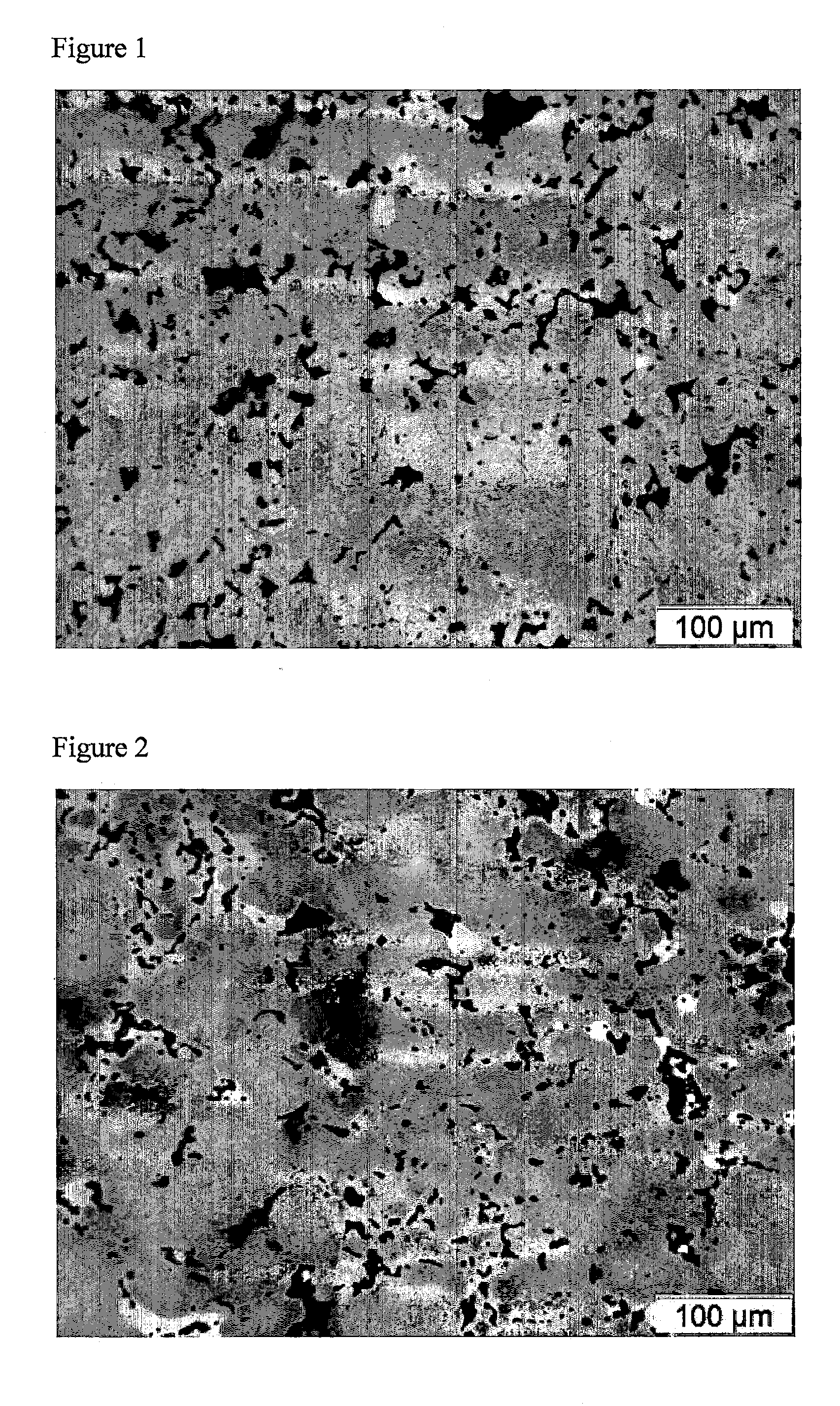High strength low alloyed sintered steel
- Summary
- Abstract
- Description
- Claims
- Application Information
AI Technical Summary
Benefits of technology
Problems solved by technology
Method used
Image
Examples
example 1
[0047]Alloyed iron-based steel powders were produced by admixing alloying elements to pure iron powder, and by heat treatment of the powder mixture in reducing atmosphere, bonding the smaller alloying element particles by diffusion to the larger particles. Table 1 shows the chemical compositions of the different powders. The particle sizes of the all powders (A, B, Ref 1-3) were below 150 μm. Powder A, B were both based on iron powder ASC100.29, available from Höganäs AB, and were diffusion bonded with a Ni-containing powder (fine particles of essentially pure Ni) and a Mo-containing powder (fine particles of Mo-oxides). Ref. 1 was based on iron powder ASC100.29, available from Höganäs AB, and was diffusion bonded with a Ni-containing powder (fine particles of essentially pure Ni) and a Mo-containing powder (fine particles of Mo-oxides). Ref. 2 was based on iron powder ASC100.29, available from Höganäs AB, and was diffusion bonded with a Ni-containing powder (fine particles of essen...
example 2
[0058]Samples were produced and tested according to example 1, with the exception of sintering temperature, which was 1250° C. Table 3 shows added amounts of graphite to the composition before producing the test samples, and results from chemical analysis of the 1250° C. sintered and heat treated specimens. It also shows results from tensile strength testing, impact energy testing, and hardness testing.
TABLE 3Amount of added graphite, analyzed C, results from tensiletesting, impact energy testing and hardness testing.PowderAddedSinteredYieldTensileImpactcompositiongraphiteCOdensitystrengthstrengthElongationHardnessenergybased on powder[%][%][%][g / cm3][MPa][MPa][%][HRC][J]A0.60.590.037.16114612200.3238.215.2B0.60.620.027.18116812750.3838.918.0Ref. 10.60.630.037.15117112790.3938.917.5Ref. 20.60.490.037.1799712360.8234.019.6Ref. 30.60.600.057.06—10610.1236.912.0
[0059]The low alloyed samples based on powders A and B show a yield strength that is similar to the yield strength of samples ...
example 3
[0066]Samples based on powders A and ref 2 were produced and tested according to example 1, with the exceptions of sintering temperature, which was 1250° C., and in that the samples were not subjected to heat treatment after sintering, i.e. the samples were in as-sinetered state. Graphite and / or the machinability enhancing agent MnS were mixed with the powders according to the specifications of table 4. Machinability tests were performed on the samples, by drilling and counting the amount of drilled holes before total drill failure. The result are shown in Table 4.
Test geometry: 80×12 mm
Cutting data: Cutting speed, Vc=40 m / min[0067]Feed, f=0.06 mm / rev[0068]Cutting depth, ap=9.6 mm (blind), dry
TABLE 4Results of machinability testsGraphiteUsedBase powder[%]MnS [%]# holes / drilldrillsTime [min]A0.6—2400179A0.60.5>>24001>79Ref20.60.52041
[0069]As can bee seen in table 4, the machinability of as-sintered components based on powder A is much better than that of...
PUM
| Property | Measurement | Unit |
|---|---|---|
| Temperature | aaaaa | aaaaa |
| Temperature | aaaaa | aaaaa |
| Percent by mass | aaaaa | aaaaa |
Abstract
Description
Claims
Application Information
 Login to View More
Login to View More - R&D
- Intellectual Property
- Life Sciences
- Materials
- Tech Scout
- Unparalleled Data Quality
- Higher Quality Content
- 60% Fewer Hallucinations
Browse by: Latest US Patents, China's latest patents, Technical Efficacy Thesaurus, Application Domain, Technology Topic, Popular Technical Reports.
© 2025 PatSnap. All rights reserved.Legal|Privacy policy|Modern Slavery Act Transparency Statement|Sitemap|About US| Contact US: help@patsnap.com


